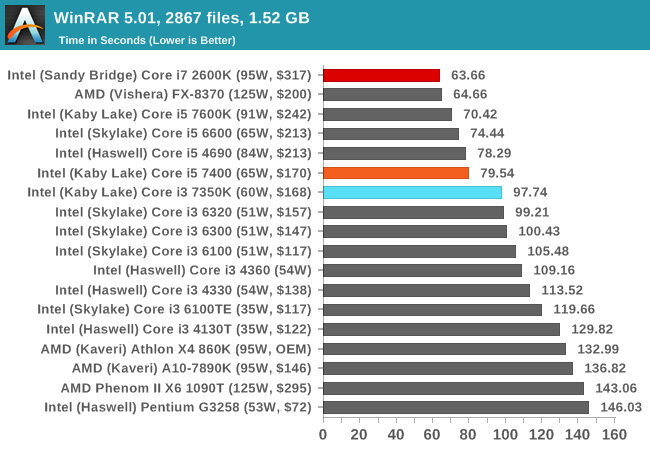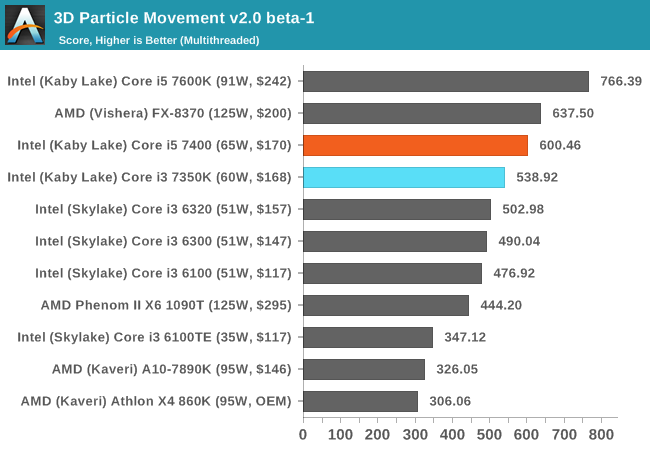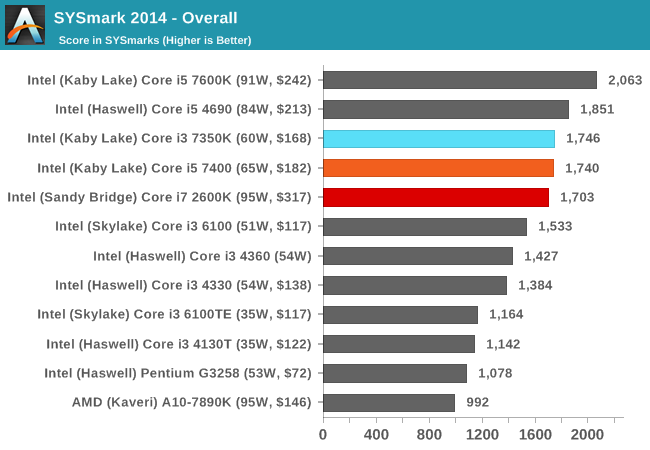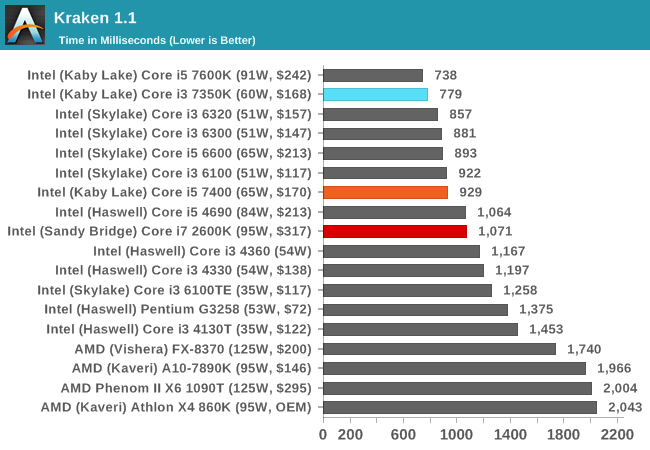The Intel Core i3-7350K (60W) Review: Almost a Core i7-2600K
by Ian Cutress on February 3, 2017 8:00 AM ESTOffice Performance
The dynamics of CPU Turbo modes, both Intel and AMD, can cause concern during environments with a variable threaded workload. There is also an added issue of the motherboard remaining consistent, depending on how the motherboard manufacturer wants to add in their own boosting technologies over the ones that Intel would prefer they used. In order to remain consistent, we implement an OS-level unique high-performance mode on all the CPUs we test which should override any motherboard manufacturer performance mode.
All of our benchmark results can also be found in our benchmark engine, Bench.
Dolphin Benchmark: link
Many emulators are often bound by single thread CPU performance, and general reports tended to suggest that Haswell provided a significant boost to emulator performance. This benchmark runs a Wii program that ray traces a complex 3D scene inside the Dolphin Wii emulator. Performance on this benchmark is a good proxy of the speed of Dolphin CPU emulation, which is an intensive single core task using most aspects of a CPU. Results are given in minutes, where the Wii itself scores 17.53 minutes.

The 7350K, with a high single thread frequency, easily surpasses the i5 and i7-2600K here. That being said, there's a slight difference to the Skylake i3, perhaps down to various generation specific code differences.
WinRAR 5.0.1: link
Our WinRAR test from 2013 is updated to the latest version of WinRAR at the start of 2014. We compress a set of 2867 files across 320 folders totaling 1.52 GB in size – 95% of these files are small typical website files, and the rest (90% of the size) are small 30 second 720p videos.

WinRAR is more geared towards a variable threaded environment but also memory speed. The fact that the Core i5 is above the Core i3 shows that having actual cores helps, regardless of frequency - the additional hyperthreads for the Core i7-2600K also gives it the win, despite the memory frequency difference.
3D Particle Movement v2
3DPM is a self-penned benchmark, taking basic 3D movement algorithms used in Brownian Motion simulations and testing them for speed. High floating point performance, MHz and IPC wins the day. This is the second variant of this benchmark, fixing for false sharing in the first version, and lending itself to better multithreaded performance.

3DPMv2 is still new, so we don’t have too many results for it so far - but again this is another situation where having actual cores helps. This is typically when the threads are 'heavy', i.e. spill out into various caches and require more than 1/2 the cache shared within a core each. In the case of the Kaby Lake, this means that each core has 32KB of L1 - or 32KB per thread for the i5 but only 16KB per thread in the i3.
SYSMark 2014
Engineered by BAPco (to which Intel is a consortium member), this set of tests are designed to be an office/data/media/financial range of tests using common well-known CAD, image editing, web browsing and other tools to put out a score, where a score of 1000 is attributed to an old Core i3 using a mechanical harddrive. Here we report the overall score, however the test breakdowns can be found in Bench.

Because SYSMark is a variety of tests that rely on response and throughput, here is where the Core i3 comes into play over the i5 and i7-2600K. With the i5 it's about equal, but the years of IPC increases put the i7-2600K now behind the Kaby i3.
Web Benchmarks
On the lower end processors, general usability is a big factor of experience, especially as we move into the HTML5 era of web browsing. For our web benchmarks, we take well-known tests with Chrome as installed by SYSMark as a consistent browser.
Mozilla Kraken 1.1

Kraken favors high frequency and IPC, so the i3 takes a large lead over the i7-2600K for this sort of workload.










186 Comments
View All Comments
BillBear - Friday, February 3, 2017 - link
For consumers who intend to purchase a discrete GPU card, it's interesting to see it confirmed that Intel could include four additional CPU cores in instead of the unnecessary (for you) integrated GPU within pretty much the exact same die size.It wouldn't cost them more to manufacture than an i7. They just want to be able to charge more money by forcing you into a different price range of product if you need many cores.
For instance: Intel’s new 10-core Core i7 Extreme Edition costs a whopping $1,723
http://www.geek.com/tech/intels-new-10-core-core-i...
fanofanand - Friday, February 3, 2017 - link
I'm not sure I agree with your assessment. Intel has a vested interest in pushing people like you into the HEDT platform which is far more profitable. If you have a powerful dGPU then you are not "mainstream" by Intel's thinking. Based on the number of computers that have no dGPU maybe they are right.BillBear - Friday, February 3, 2017 - link
You're just defending price gouging now.fanofanand - Sunday, February 5, 2017 - link
I am not defending anything, I am neither an Intel shareowner nor have they seen a penny of mine in a decade. I am saying that what they are doing makes business sense even if it doesn't suit you as well as you'd like.BillBear - Sunday, February 5, 2017 - link
For someone who frequently responds to other people's posts with silly BS like "This post brought to you by CompanyName" why are you suddenly defending price gouging on Intel's part?Price gouging makes business sense for any company. Tacking on an additional thousand dollars per part? Not really defensible.
block2 - Friday, February 3, 2017 - link
The CPU I want is one that costs me the least electricity for the 95% of the time when I'm on Facebook and surfing, yet supports Photoshop well. I bought a gold rated seasonic PSU a couple years ago and my overall power usage is very low (40w?). Really, a low end i3 ought to suffice for me. I'm still using a 2.8ghz AMD phenom II with the CPU throttling enabled (800mhz).Scipio Africanus - Friday, February 3, 2017 - link
Have you considered one of the Intel T suffix cores? They don't get a lot of coverage but give you the newest architecture with a very low TDP. The current Kaby Lake T cores are 35w TDP.The newest review i could find was for Haswell T cores:
http://www.anandtech.com/show/8774/intel-haswell-l...
Scipio Africanus - Friday, February 3, 2017 - link
It takes Intel 6 years to post 25% increase in single threaded performance? Yeesh. Competiton (read: Ryzen) can't come fast enough. My Sandy Bridge Dell Precision is staying put for a bit more.StrangerGuy - Friday, February 3, 2017 - link
And AMD did what exactly during the same 6 years? Sheesh.silverblue - Saturday, February 4, 2017 - link
Well, they've transformed a power-hungry server architecture into something that the majority of users could use in a mobile device without complaining about power or performance. I'm also pretty sure that if they had commissioned Zen even before Bulldozer's release, we still wouldn't have seen anything until recently. I'm not going to defend them for Bulldozer, but it was either trash it and work on a replacement with no money coming in or at least try to fix its problems with power, L1 and decoder, and redesign the FPU. A 25%+ IPC boost from Bulldozer to Excavator, despite the loss of L3, would have been much better received had Bulldozer been better to begin with. That's what AMD have been doing.